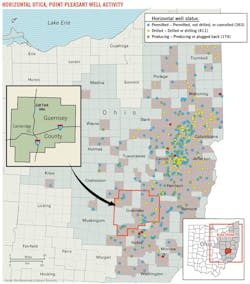Guernsey County lays groundwork for rising Utica shale drilling activity
GUERNSEY COUNTY, Ohio—When word first got out that the rural city of Cambridge, Ohio, sat atop a bounty of resources in the Utica shale, the president of the local chamber of commerce wasted no time laying the groundwork for the expected push for development.
Joanne "Jo" Sexton, president of the Cambridge Area Chamber of Commerce, got right to work learning more about the burgeoning play and what development could mean for Cambridge, the seat of Guernsey County in southeast Ohio—in the core of the condensate-rich portion of the Utica shale.
Sexton said one of the first orders of business was a trip to Williamsport, Pa., to learn from the experience of a city several years into the development of the Marcellus shale. "We visited with them and learned a lot of things about what to do and what not to do," Sexton told UOGR.
From that visit emerged the idea of holding an ongoing educational meeting. The Guernsey Energy Coalition was formed to give community leaders and residents an opportunity to learn about the oil and gas industry and to offer a forum for raising questions and concerns.
Sexton said the nearly 3-year-old coalition hosts monthly meetings featuring a range of expert speakers, including geologists, attorneys, exploration and production company executives, and representatives from the Ohio Department of Natural Resources. One meeting featured a screening of the controversial film "Gasland."
"At the beginning there were a lot of questions," Sexton said. Attendees wanted to know what hydraulic fracturing and horizontal drilling were. "Human nature is that people are afraid of what they don't understand."
Bringing in experts to educate key community leaders played an important role in getting people comfortable with the industry and fostering community acceptance, Sexton said. Coalition meetings are broadcast by the local television station and streamed over the internet.
"Once people started understanding how things work and how safe everything is, very quickly they became accepting of it and, for the better part of 2 years it's just been incredible," Sexton said.
Utica development ramps up
The Guernsey Energy Coalition is now more than 200 members strong, and Cambridge is looking at ways to prepare local infrastructure to handle newcomers arriving in the community. Sexton said the town is "running out of buildings" and is working to extend city services like sewage, water, and roads to new developments.
Among the arrivals are companies that clean drilling pads, trucking firms, and water analytics firms. "We've had a lot of new people; a lot of companies have come to set up shop," Sexton said.
Cambridge is located at the intersection of two major highways—Interstate 70 and Interstate 77—making it a good central location for companies working in the area.
Figures from the Ohio Department of Natural Resources show that Utica development is picking up in the county. Through mid-November, the state agency had issued 61 permits to drill wells targeting the Utica/Point Pleasant shale in Guernsey County. It ranks as the fifth most active area of permitting in the state behind Carroll, Harrison, Columbiana, and Noble counties. The list of exploration and production companies with permits to drill in Guernsey County includes Anadarko Petroleum, Chesapeake Energy, Gulfport Energy, and Hess.
Craig Kasper, CEO of Hull & Associates Inc., Addresses teh Guernsey energy coalition. The coalition's monthly meetings give locals a chance to learn more about development of Marcellus Shale.
Photo Courtesy of Chambridge Area Chamber of Commerce.
Prior to Utica development, Sexton said, Cambridge was a depressed area with an unemployment rate above 12%. "There was just nothing going on. Kids were graduating from high school and leaving and not coming back," Sexton said. Figures from the federal Census Bureau show the city's population shrunk to 10,600 residents in 2010 from 11,500 in 2000.
Now the population is growing as people return to the city to take advantage of new economic opportunities. The unemployment rate has fallen to 7.5%, and Sexton said investments are being made in cultural, economic, and workforce development. Zane State College's Cambridge Campus is adding programs that prepare students to work in the field, and Ohio University opened a facility in Cambridge that began offering classes in January 2014.
As of November, four hotels were under construction to serve the new faces arriving in the historic city. "It's just rejuvenating this very depressed area," Sexton said of the Utica.
Refueling station eyed
The Cambridge Area Chamber of Commerce recently hosted the first meeting of a task force that is exploring the use of natural gas-powered vehicles. Zane State College opened its first natural gas vehicle (NGV) refueling station for campus vehicles in November, and one area company, Hartley Oil Co., plans to instal a slow-fill compressed natural gas (CNG) refueling station for its own vehicles.
The city is considering the installation of an NGV refueling station for the use of the general community. Sexton said the Chamber of Commerce often receives calls from motorists searching for a place refill their NGVs. "We realize that we're going to have to make some kind of investment in fueling stations here, and then we think we'll see a lot of fleet vehicles start converting to natural gas."
In November, the energy coalition hosted a representative from Ariel Corp., an Ohio-based manufacturer of gas compressors used in CNG refueling stations, who touted the benefits of natural gas as a transportation fuel. Sexton said the chamber hopes to work with partners to get the project off the ground. "We're really trying to learn and rise to the occasion," she said.



